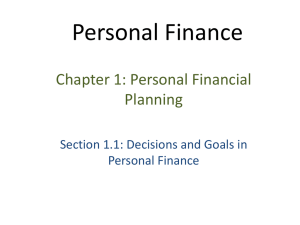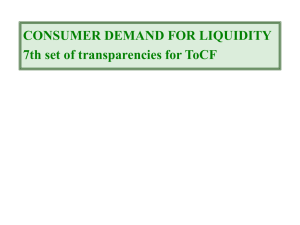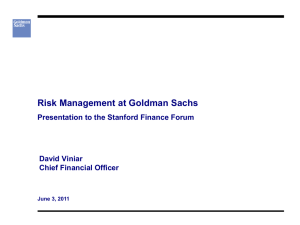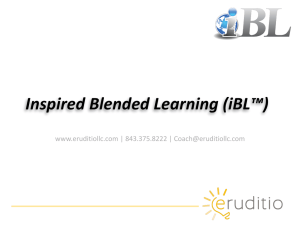Bank of England * Outright Purchases
advertisement
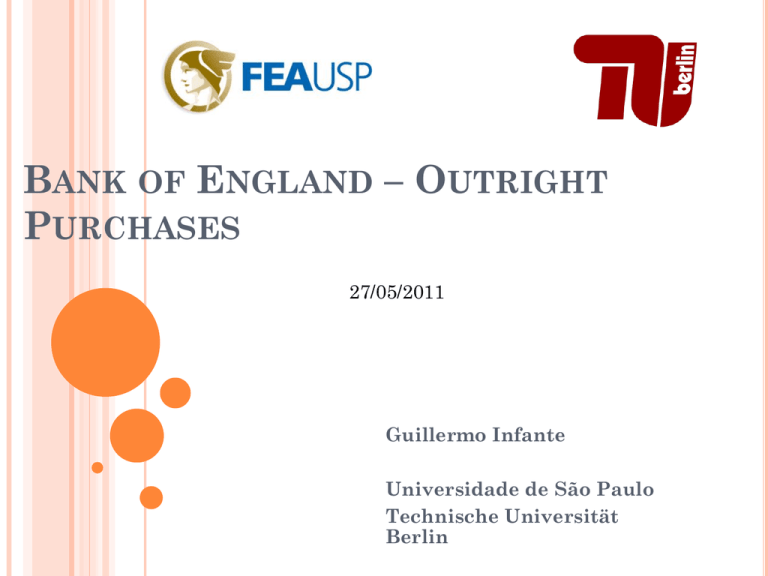
BANK OF ENGLAND – OUTRIGHT PURCHASES 27/05/2011 Guillermo Infante Universidade de São Paulo Technische Universität Berlin BANK OF ENGLAND’S MISSION Core Purpose 1 - Monetary Stability Monetary stability means stable prices and confidence in the currency. Stable prices are defined by the Government’s inflation target, which the Bank seeks to meet through the decisions delegated to the Monetary Policy Committee. Core Purpose 2 - Financial Stability Financial stability entails detecting and reducing threats to the financial system as a whole. Such threats are detected through the Bank’s surveillance and market intelligence functions. The inflation target The inflation target of 2% is expressed in terms of an annual rate of inflation based on the Consumer Prices Index (CPI). Interesting remark The remit is not to achieve the lowest possible inflation rate. Inflation below the target of 2% is judged to be just as bad as inflation above the target. The inflation target is therefore symmetrical. BANK RATE - CHAIN OF ECONOMIC EFFECTS HOW TO PROCEED IN TURBULENT TIMES? WHAT TO DO IF THE BANK RATE IS ALMOST ZERO AND THE ECONOMY CONTINUES TO STRUGGLE? The BoE can increase the quantity of money – in other words - injects money directly into the economy. That process is sometimes known as ‘quantitative easing’. The MPC makes its decision independently of the government. OUTRIGHT TRANSACTIONS They refer to the operations where the BoE buys or sells securities outright (on the spot) in the market. Such operations are not reversible and have permanent effect in the money market liquidity. An outright transaction implies a full transfer of ownership from the seller to the buyer with no reverse transaction. PROVIDING LIQUIDITY = OUTRIGHT PURCHASE OF SAFE SECURITIES Outright purchases are used to provide liquidity to the greater economy. The BoE buys assets and pays them outright (on the spot) with new created money. This newelectronically created money is deposited in the commercial bank of the former owner of the asset. This money can now be transformed in consumption of goods, investment, or it can stay “idle” in the bank, helping to restart the proper functioning of the credit system. QUANTITATIVE EASING - CHAIN ON ECONOMIC EFFECTS WHAT DID THE BOE CREATE TO FIGHT THE RECESSION? extended the drawdown window for new debt under the Government’s Credit Guarantee Scheme (CGS) which is designed to reduce the risks on lending between banks; established a new facility for asset backed securities; extended the maturity date for the Bank of England’s Discount Window Facility which provides liquidity to the banking sector by allowing them to swap less liquid assets; established a new Bank of England facility for purchasing high quality assets; offered capital and asset protection scheme for banks, with proposals for this to be co-ordinated internationally; clarified the regulatory approach to capital requirements, through an announcement by the Financial Services Authority (FSA) WHY DID THE BOE PROCEED WITH THE OUTRIGHT PURCHASES OF FINANCIAL ASSETS? Creates excess reserves, boosting the economy Brings long-term yields down Eases the bank’s capital constraints Improves the funding liquidity situation of the banks Supports the funding liquidity of the issuing institutions Supports secondary market liquidity Supports new issuance activity and refinance of the real sector Supports asset prices Compresses spreads WHICH ASSETS CAN BE BOUGHT WITH THE ASSET PURCHASE FACILITY “APF”? The Bank is currently purchasing three different types of high-quality assets through the APF: investment-grade commercial paper; investment-grade corporate bonds; UK government bonds (gilts). Other assets, such as paper issued under the Credit Guarantee Scheme, syndicated loans and certain types of asset-backed securities are also included on the list of assets that are eligible for purchase by the APF, and could be considered in due course. IN FINANCE: THE QUICKER, THE BETTER The Bank buys assets from private sector institutions (insurance companies, pension funds, banks or non-financial firms) and credits the seller’s bank account. So the seller has more money in their bank account, while their bank holds a corresponding claim against the Bank of England Table A above summarizes the amount of assets that the Fund has purchased and sold each week of 2011 Q1 Chart 1 shows the cumulative asset purchases by type since the establishment of the Fund. As at 31 March 2011, cumulative assets purchased totalled £200 billion. THE EFFECT ON THE BOE BALANCE SHEET The Bank can create new money electronically by increasing the balance on a reserve account. So when the Bank purchases an asset from a bank, for example, it simply credits that bank’s reserve account with the additional funds. This generates an expansion in the supply of central bank money. CHALLENGES CONCERNING OUTRIGHT PURCHASES Isn’t liquidity only created if the haircuts on private papers purchased are very high? What is the correct size of an outright purchase program? Can the Central Bank build up the necessary expertise and risk management capabilities? Isn’t the Central Bank paying too much for an asset due to the illiquid market? How can the Central Bank define the eligible universe of securities that can be purchased? What is the best purchase technique? Isn’t the Central Bank distorting the prices? THANK YOU!




